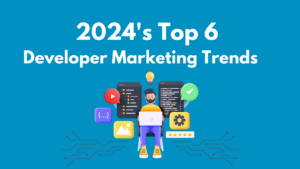Software is eating the world. Marc Andreessen said it in 2011, and it’s even more true today — so software developers are an essential audience. They’re often the kingmakers or dealbreakers that can ensure a product is adopted or ignored.
So how do you connect with developers in a way that makes them like you and not ignore you? In a webinar co-hosted by Appsembler and ContentLab titled Developer Education on the Frontlines, we make the case that developer education — especially in the form of developer learning courses — is a crucial way of cutting through the noise and providing value to developer audiences.
I represented ContentLab at the webinar alongside Appsembler’s CEO, Nate Aune, and I’d like to share some of my favorite tips and best practices you’ll pick up from the webinar.
You Can’t Ignore Software Developers
Nate introduced a statistic that I found to be a real eye-opener: failure to get developer buy-in causes the loss of 34% of software sales opportunities. Wow!
As someone who has developed software for over a decade, I’ve seen developer influence in action. I’ve been the developer influencing purchase decisions — and even I was surprised by the magnitude of developer impact here.
Developer Courses Work Alongside Existing Content
In talking to ContentLab’s clients about self-paced developer courses, I’ve often encountered a bit of anxiety because many marketers feel that courses are very different from other types of developer-focused content.
In reality, courses serve as a great complement to existing content. For example, your developer-focused blog posts and tutorials are already bringing traffic to your website, so it’s easy to add a call-to-action at the end, suggesting readers sign up and try a course if they’d like to learn more.
Similarly, you can use blog posts and tutorials to keep learners engaged after completing a course. Developers who finish a course might not always be ready to dive into another one right away. Still, they often appreciate a follow-up e-mail suggesting related posts they might enjoy.
Creating Developer Courses is not Difficult
Another common worry is that an organization’s existing skills in producing blog posts and tutorials won’t carry over to creating courses.
Fortunately, in producing many courses at ContentLab, we’ve found that you can easily adapt existing content creation processes and personnel to create courses. If you already create blog posts and tutorials, you’re likely already writing content outlines and working with technical content creators.
The good news is that with a few minor changes, you can use your existing content creation process to produce courses as well. Writing a course syllabus isn’t much different from writing a tutorial outline, and with a little bit of advice and coaching, tutorial authors usually make great course creators.
You Can Start Small with One Developer Course
Nate and I both agree that it’s helpful to start small. Even if you’re all-in on courses and you’re sure you want to build out a complete course catalog, it’s best to start with one. Without much difficulty, a single course creator can build out a developer course in a few weeks.
Starting small has advantages. If you’re new to course creation, beginning with one course lets you learn and iterate as you go. If you make any beginner mistakes, you’ll only make them on one course, and they’ll be easy to fix. You can learn what works for your audience and what doesn’t and then use those lessons to produce your future courses more quickly and effectively.
Developer Courses Help You Understand Your Audience
While blog posts and tutorials are a great way to reach developer audiences, you’re limited in how much data you can gather. Of course, you’ll know how many people viewed the page and roughly how long they spent reading it, but there’s a limit to how much you can learn.
Developer courses, in contrast, offer much deeper insight into how your audience is engaging with your content. To start with, developers typically must register for a course before they can begin working through it. That alone is an important milestone that demonstrates commitment. Then, you can track how far they get through the course, how quickly they do it, whether they complete it, and whether they download badges or certificates.
Finally, consider lead quality: a developer who completes a course has demonstrated much more interest and intent than a lead who only downloads a whitepaper.
Watch the Webinar to Learn More
As we’ve seen, developer education and developer courses play a key role in connecting with modern developer audiences.
If you like what you’ve read, consider watching the webinar! It covers everything I’ve discussed here and much more!
About the Author
Ryan Peden is a developer and marketer who lives at the intersection of business and technology. He loves writing code, writing about code, and planning developer marketing strategy. Visit him on LinkedIn.



